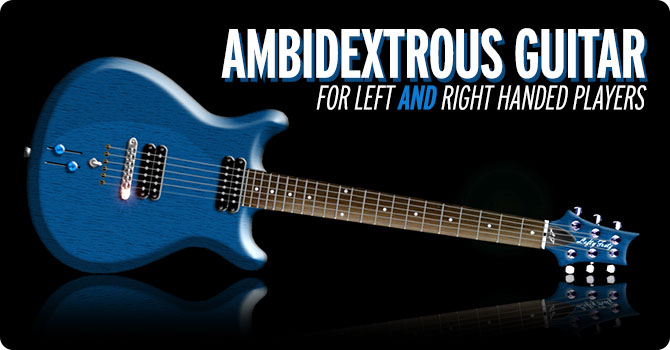
Is there such a thing as an ambidextrous guitar?
Last month I wrote an article describing why restringing a right handed guitar for a lefty was generally a bad idea.
I received a handful of amusing comments back from readers who recalled many of the troubles that they had when they first started playing guitar and simply restrung their dad’s old right handed model upside down.
This got me thinking…
How hard could it be to design a guitar that could be played by both left and right handed players? It’s probably the most ridiculous idea I’ve ever had, but hey, wouldn’t it be fun to try and design something like that?
Well, I spent a lonely evening in Photoshop and came up with the ambidextrous guitar design above. Please don’t take this idea too seriously, it’s just a bit of fun…
Ambidextrous Guitar Design
A Left AND Right Handed Guitar
This is a guitar that through some very minor adjustments could be set up for either left handed or right handed players. It would be aimed purely at beginner players and would be the only left handed guitar in the world that any store would be happy to stock more than one of.
The guitar would be mass-produced, and would be priced at the lower end of the market to make it appealable to new players who don’t necessarily want to spend too much on a new hobby.
Imagine walking into a music store as a new lefty player and asking the salesman what left handed guitars he has in stock. “Oh, well I’ve got a couple of Strat copies in black, a Les Paul copy in black, and I think there’s a Tele copy somewhere… it’s black “.
Your heart sinks.
“But wait, I’ve also got these 2-in-1 models, if you give me 5 minutes I can switch them to being left handed and you can have one in any of these 10 colors I have in today “.
The Features
Symmetrical Design. The guitar features a symmetrical design to ensure an efficient playing experience when played either right or left handed. One problem with restringing a right handed guitar upside down is poor access to the upper frets due to the body obstructing access. The double cutaway design here will eliminate this problem completely.
Volume and Tone Sliders. A further problem associated with playing a right handed guitar upside down is that the direction in which the pots are operated will be reversed. This dilemma has been overcome via the use of sliders, with control of the sliders remaining the same regardless of dexterity. As the guitar is aimed at the beginner market it isn’t expected that controls will be operated during play, so locating them at this harder-to-reach position should not be a problem. Levels can be set before beginning to play.
Pickup Selector Switch. The switch has been sited in a central position behind the bridge to again ensure that operation remains universal regardless of dexterity. Move it toward the neck to select the neck pickup, and away from the neck to select the bridge pickup.
Bridge. The bridge will be fixed to ensure beginner friendliness. It will also be slightly deeper than usual to allow for a greater range of intonation adjustment when switching playing direction. The deeper-than-usual bridge would also result in the knife edges being taller than usual in order to avoid the strings touching the sides of the bridge.
Nut. The nut will be held in place by a spring clamp mechanism. To switch from a right handed to a left handed position it can simply be lifted up, rotated 180 degrees, and snapped back into place, ready for restringing. If this method is found to be too unstable then an alternative design feature could be to include an extra left handed nut with the guitar that could be easily snapped into place.
Strap Pegs. The rear strap peg will be located at its usual position at the bottom of the guitar. However, the front peg will be centrally located beneath the neck and body join to ensure that the guitar can be comfortably worn lefty or righty.
Is it Feasible?
Would a company actually build a guitar like this? Probably not! At least not without a hell of a lot of additional refinements!
Due to the more complex design and unique parts of this guitar, the cost of production would obviously be much higher than that of a regular beginner guitar. Plus, at best, only 5-10% of players would actually bother to switch it over. In fact, it would probably be cheaper for them to straight up buy a left handed guitar!
If such a small number of people would actually make use of the guitar’s big design feature it kind of defeats the whole purpose of it, right?
At best this is just a fun idea that could certainly make for an interesting project build for someone! If anyone is handy with wood, why not have a go? Send me some photos or a video and I’ll happily feature it!
Other Ambidextrous Guitars
Fender Ambicaster

In 2019, Fender released the Ambicaster, a quirky double-necked guitar that can be played either left or right handed. Click here to find out more.
Fender Equality Series
In 2021, Fender went even further and released an entire range of ambidextrous guitars – The Equality Series! Click here for more information.

Michael Angelo Batio Double Guitar
Who can forget shred guitarist Michael Angelo Batio and his insane double and quadruple-necked guitars? He is probably the most famous ambidextrous guitar player out there at the moment!
Watch him shredding it up on his double-neck Dean in the video below!


